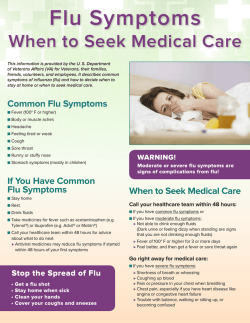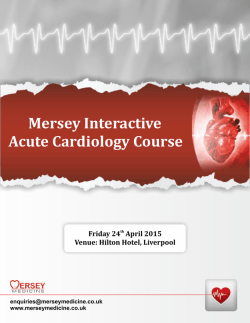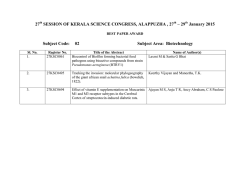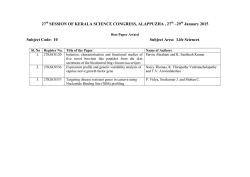
Download [ PDF ] - journal of evolution of medical and dental sciences
DOI: 10.14260/jemds/2015/255 ORIGINAL ARTICLE CLINICAL PROFILE OF RHEUMATIC FEVER AND RHEUMATIC HEART DISEASE IN CHILDREN UNDER 15 YEARS AGE GROUP AND ITS CORRELATION WITH ECHOCARDIOGRAPHY P. Ramu1, R. Bhavani Shankar2 HOW TO CITE THIS ARTICLE: P. Ramu, R. Bhavani Shankar. “Clinical Profile of Rheumatic Fever and Rheumatic Heart Disease in Children Under 15 Years Age Group and its Correlation with Echocardiography”. Journal of Evolution of Medical and Dental Sciences 2015; Vol. 4, Issue 11, February 05; Page: 1786-1776, DOI: 10.14260/jemds/2015/255 ABSTRACT: Context (Back ground) Acute Rheumatic fever and Rheumatic heart disease are the most common acquired childhood heart disease in India. It is well established that 2 D Echo cardiography is more sensitive in picking up minor degrees of valvular regurgitation than clinical examination. AIMS & OBJECTIVES: To study the clinical profile of “Rheumatic Fever and Rheumatic heart disease“ & correlate it with Echocardiographic findings in Children under 15 years age group presenting to a tertiary care hospital. MATERIALS AND METHODS OF STUDY: Thirty six cases of Acute Rheumatic fever, which includes eight cases of first attack and twenty eight cases of reactivation of Rheumatic fever were studied over a period of two years in paediatric medical wards, King George Hospital, Visakhapatnam. The revised (1992) modified Jones criteria with the 1988 WHO modification was taken as a criterion to diagnose Acute Rheumatic fever. RESULTS: Peak age of Acute Rheumatic fever and Chronic Rheumatic heart disease is between 5-10 years (55.8%). No sex variation has been observed. Fever and joint involvement are the most common clinical manifestations (87.5%each) in first attack cases. Active carditis (75%) the second most common manifestation, followed by arthralgia (25%) and sore throat (25%), chorea, chest pain, abdominal pain were infrequent manifestations found to be 12.5% each. None of the cases had Erythema marginatum. CONCLUSION: In the present study the clinical findings were correlated with that of previous studies and Echocardiographic findings were correlated well as far as moderate to severe lesions. Further Echocardiography was proved to be more sensitive in detecting even trivial or mild aortic regurgitation and mitral or aortic stenosis. KEYWORDS:- Acute Rheumatic fever, Chronic Rheumatic heart disease, Echo- Cardiography, Carditis. INTRODUCTION1, 2: The incidence of Rheumatic fever is very low in developed countries compared to developing countries. The attack rate has come down to as low as 0.2/ lakh population in developed countries while it remained high in developing countries. The group A Beta hemolytic streptococcus causes Rheumatic fever is a firmly established fact and though there is no experimental model to support this fact, clinical, epidemiological immunological evidence is there to support this fact. The available data regarding prevalence rate for Rheumatic heart disease in India as follows: In the village population near Agra was 2/1000 and in the urban population of Chandigarh it was 2.07/1000 for women and 1.23/1000 for men. Similar figures were obtained in Delhi. A survey of 11 cities in India showed a prevalence rate of 0.55 to 0.67/1000. A survey conducted by the Indian council of Medical Research (ICMR) involving 133, 000 children 6 to 16 years in age showed the incidence to be 5.3/1000. Whereas incidence of Rheumatic fever following J of Evolution of Med and Dent Sci/ eISSN- 2278-4802, pISSN- 2278-4748/ Vol. 4/ Issue 11/Feb 05, 2015 Page 1786 DOI: 10.14260/jemds/2015/255 ORIGINAL ARTICLE streptococcal throat infection in the western countries is 0.3 percent in the general population and 1 to 3 percent in crowded communities like army barracks. This shows the magnitude of the problem in the country. The sexes are nearly equally affected, but mitral valve disease and chorea are more common in females whereas aortic valve, involvement is seen more often in males. RHEUMATIC FEVER DEFINITION AND CLINICAL MANIFESTATIONS1, 2: Rheumatic fever is a multi systemic disease affecting primarily the heart, joints, brain, cutaneous and subcutaneous tissue secondary to an immune reaction to Group A Beta hemolytic streptococcal infection by rheumatogenic strains 1, 3, 5, 6, 18 and 24.Reactivation of Rheumatic fever of only by Group A streptococcal pharyngitis but not by any other infection or illness. The frequency of manifestation varies from study to study depending on patient selection whether initial attacks or recurrent attacks were included and on the changing pattern of Rheumatic fever. There is no single symptom, sign or laboratory test that is diagnostic of Acute Rheumatic fever and carditis. Revised, edited and updated Jones criteria are guidelines to assist practitioners and are not a substitute for clinical judgment. DIAGNOSIS OF RHEUMATIC FEVER1, 2, 3: is based upon satisfying the Jones criteria [updated 1992] with WHO recommendations added to it. The division of criteria into major and minor has no correlation with the frequency, severity or prognosis of the disease process. The term ‘major’ only relates to the diagnostic importance. In developing countries where erythema marginatum is practically never seen due to the complexion and where polyarthralgia is common it is recommended that polyarthralgia be taken as a major criteria with evidence of preceding streptococcal infection and raised ESR if other causes of polyarthralgia can be ruled out, to avoid under diagnosis of Rheumatic fever. The diagnosis of Rheumatic fever requires the presence of 2 major or 1 major and 2 minor criteria with supporting evidence of antecedent group A Streptococcal infection taken as essential criteria (1992)3. Supporting Evidence of Antecedent Group A Streptococcal Infection: Positive throat culture or rapid streptococcal antigen test Elevated or increasing streptococcal antibody titer. J of Evolution of Med and Dent Sci/ eISSN- 2278-4802, pISSN- 2278-4748/ Vol. 4/ Issue 11/Feb 05, 2015 Page 1787 DOI: 10.14260/jemds/2015/255 ORIGINAL ARTICLE The diagnosis of Rheumatic fever can be made without satisfying 2 major/2 minor + 1 major criteria and obtaining evidence of Streptococcal infection in cases of(1) Chorea, if other causes are excluded(2) insidious/late onset carditis with no other explanation. In patients with documented Rheumatic heart disease the presence of one criterion or of fever, arthralgia, an elevated acute phase reactant suggests a presumptive diagnosis of recurrence, with evidence of preceding Streptococcal infection. If arthritis is taken as major criteria, arthralgia should not be taken as minor criteria and if carditis is taken as major criterion, prolonged P-R interval should not be taken as minor criterion. ECHOCARDIOGRAPHY (2D ECHO)2,3,: For the first time, the role of echocardiography was discussed in the latest revision of Jones criteria by American Heart Association (1992) for the diagnosis of Acute Rheumatic fever. The conclusion was that “at present there is insufficient information to allow the use of echocardiography, including Doppler, to document valvular regurgitation without accompanying auscultatory findings as the sole criterion for valvulitis in Acute Rheumatic fever”. These guide lines also highlighted a sub group of “exception to Jones criteria” (Patients with chorea, indolent carditis and those with a previous history of Rheumatic fever or Rheumatic heart disease). In which a diagnosis of Rheumatic fever can be made without strictly following the Jones criteria. It is well established that Doppler Echo is more sensitive in picking up minor degrees of valvular regurgitation than clinical examination. To differentiate physiological from pathological leaks, certain guidelines have been given. Physiological leaks usually do not extend more than one cm beyond the valve coaptation point. Also the regurgitant signal does not last throughout the phase of cardiac cycle i.e. a physiological mitral regurgitation signal is not holosystolic. Whereas pathological regurgitation is seen as a substantial color jet in two planes extending well beyond the valve leaflets and the signal lasts all through the phase of cardiac cycle with a well-defined high velocity spectral envelope. There are several studies on the use of Echocardiography to enhance the yield of cases with carditis. However, according to the proceedings of the Jones criteria workshop published in 1992, there are insufficient data to support a revision of the Jones criteria and reaffirmed the guidelines iterated in the 1992 statement. At present, Doppler echocardiography should be used as an adjunctive technique to confirm clinical findings and to evaluate chamber sizes, ventricular function, degree of valvular regurgitation, and morphological features of the valves. AIMS & OBJECTIVES: To study the clinical profile of “ RHEUMATIC FEVER AND RHEUMATIC HEART DISEASE “ & correlate it with clinical data & Echocardiography findings in Children under 15 years age group presenting to King George Hospital. MATERIALS AND METHODS OF STUDY: Thirty six cases of Acute Rheumatic fever, which includes eight cases of first attack and twenty eight cases of reactivation of Rheumatic fever were studied during the period 2004-2006 from paediatric medical wards, King George Hospital, Visakhapatnam. The revised (1992) modified Jones criteria with the 1988 WHO modification was taken as a criterion to diagnose Acute Rheumatic fever.3 J of Evolution of Med and Dent Sci/ eISSN- 2278-4802, pISSN- 2278-4748/ Vol. 4/ Issue 11/Feb 05, 2015 Page 1788 DOI: 10.14260/jemds/2015/255 ORIGINAL ARTICLE Children of age group less than 15years, satisfying Rheumatic fever and Rheumatic heart disease criteria both in inpatients of paediatric wards, as well as those who are attending the OP Dept. in King George Hospital for a period of 2 years (i.e. from July 2004 to June 2006) are included in the study with respect to the following: 1. Clinical Profile of the patient. 2. Sex Incidence. 3. Confirmation by investigations like E.C.G. X-Ray and. 4. Echo cardiographic Evaluation and Correlation. OBSERVATIONS AND DISCUSSION: AGE & SEX DISTRIBUTION <5 5-10 11-15 Total No. of cases % of cases years years Years Males 12 6 18 50 Females 8 10 18 50 % of cases 0 55.6 44.4 36(100%) 100 Table I This study shows that the peak age for Acute Rheumatic fever & Chronic Rheumatic Heart disease is between 5-10 years. 55.6% cases were in the 5-10 years age group while 44.4% were in the 11-15 years age group. No sex variation has been observed in this study in agreement with most other studies and text books while male preponderance was observed in Devichand study4 and King George hospital study in 1965. CLINICAL PROFILE OF FIRST ATTACK AND REACTIVATION OF RHEUMATIC FEVER: % CASES attack Reactivation No. of Cases=8 No. of Cases =28 Fever 87.5 60.71 Joint involvement 87.5 39.28 Polyarthritis 62.5 25 Monoarthritis Arthralgia 25 10.71 Active Carditis 75 25 Congestive cardiac failure 37.5 50 Sore throat 25 3.57 Chorea 12.5 7.14 Chest pain 12.5 17.85 Abdominal Pain 12.5 7.14 Subcutaneous nodules 12.5 7.14 Erythema marginatum TABLE II Clinical Feature 1st This study shows the clinical profile of 1st attack and reactivation of Rheumatic fever in the order of frequency of their occurrence. Fever is the most common clinical manifestation seen in J of Evolution of Med and Dent Sci/ eISSN- 2278-4802, pISSN- 2278-4748/ Vol. 4/ Issue 11/Feb 05, 2015 Page 1789 DOI: 10.14260/jemds/2015/255 ORIGINAL ARTICLE 87.5% of first attack cases and 60.71% of reactivation cases. Next common manifestation is joint involvement seen in 87.5% of first attack cases and 39.28% of reactivation cases. The incidence of carditis in1st attack (75%) was greater than in reactivation cases (25%), but the point to be noted is that congestive heart failure occurred in only 38.46% of cases with carditis in 1st attack while carditis presented with congestive heart failure in all cases (100%) of reactivation. Abdominal pain was noted to be an infrequent symptom in both presentations (7.14-12.5%). Sore throat was noted to be more frequent in 1st attack [25%], while chest pain was significantly higher in reactivation cases 17.85% compared to first attack 12.5%. Chorea was noted in both 1st attack and reactivation cases and accounting for 12.5 &7.14% respectively. Out of 36 cases in the present study 3 cases of Chorea found and two of them were males and one female, in contrary to the standard text book teaching of Chorea is more common in females. This may be due to the short duration of study and small number of cases included in the present study. Subcutaneous nodules were seen in both first attack and reactivation cases and accounting for 12.5&7.14% respectively. Arthralgia was found to be a more common manifestation than Erythema marginatum in both cases. Erythema marginatum was not seen in any case. This agrees with the observations made by Cherian, B. L. Agarwal that Erythama marginatum be delineated as a major criterion as it is never seen in dark skinned races. PRESENTATION OF CARDITIS: Myocarditis & endocarditis Particarditis / pericardial effusion Congestive heart failure Mary G.Wilson’s4 study 1930-1955(165cases) 100% 20% 45% TABLE III Present study 2004-2006 (36 cases) 100% 23% 38.46% This study shows that myocarditis is seen in all cases presenting with carditis and is in agreement with Mary G.Willson’s4 study. Pericarditis was noted in 23% in the present study while Mary, G.Willson’s study showed 20% incidence. Among cases presented with active carditis congestive heart failure was noted in 38.46% cases in present study and 45% cases in Mary. G. Willson’s study. COMPARATIVE ANALYSIS: Age Percentage of Cases Years Nair et al Present Study <, 5 10 5-10 64 55.6 > 10 26 44.4 TABLE IV The above table shows that in the present study peak incidence is seen in the age group 5-10 years as noted in Nair et al study. No cases were recorded in the age group <5 years probably due to the short period of study, but retrospectively acquired heart disease presenting as severe mitral J of Evolution of Med and Dent Sci/ eISSN- 2278-4802, pISSN- 2278-4748/ Vol. 4/ Issue 11/Feb 05, 2015 Page 1790 DOI: 10.14260/jemds/2015/255 ORIGINAL ARTICLE regurgitation following an attack of Acute Rheumatic fever has been noted even by the age of 5 years, and established cases of mitral stenosis by 7-8 years age. SEX DISTRIBUTION: Sex Males Females Nair et al 5 (100 Cases) % 52 48 Devichand K. G. H. Study Present Study Study(1960)6 (1965)50 Cases (2004-06) (36 Cases) % % % 52 69 50 48 31 50 TABLE V There is no sex variation in the incidence of Rheumatic fever but. slight male preponderance have been observed in other studies of Nair et al5 (52%), Devichand et al6 (52%). COMPARATIVE STUDY OF CLINICAL PROFILE OF 1ST ATTACK OF RHEUMATIC FEVER: Clinical Profile Nair et al Salt Lake City Present Study (1990) (1985 –86) (2004-06) % % % Joint involvement 88 N.A 87.5 Arthralgia 22 N.A. 25 Arthritis 66 62 62.5 Carditis 57 72 75 Congestive heart failure 33 N.A. 37.5 Chorea 10 30 12.5 Subcutaneous nodules 4 8 12.5 Fever 94 N.A. 87.5 Sore throat 67 33 25 N.A. No information available TABLE VI This table shows joint involvement to be commonest manifestation in both Nair et al and present study while in Salt Lake city, carditis is noted to be the commonest manifestation (72%) which is a study following resurgence of Rheumatic fever in U.S.A. this study shows that the severity of Rheumatic fever following resurgence in developed countries is similar to that in developing countries. Congestive heart failure was noted in 33% of cases in Nair et al study and 37.5% in the present study, while Chorea was noted in 10% of cases by Nair et al and 12.5% of cases in the present study. Fever is a very common manifestation noted in 87.5% cases in present study where as 94% in Nair et al study and 93% cases in Sanjay B.Roy Delhi study. Sore throat was noted in 33% of cases in Salt Lake city study and 25% in the present study. J of Evolution of Med and Dent Sci/ eISSN- 2278-4802, pISSN- 2278-4748/ Vol. 4/ Issue 11/Feb 05, 2015 Page 1791 DOI: 10.14260/jemds/2015/255 ORIGINAL ARTICLE COMPARISION OF CLINICAL PROFILE OF RHEUMATIC HEART DISEASE IN VARIOUS COUNTRIES: Clinical profile Feinstein et al (1962) (272) patients U.S.A. % Majeed et al (210 patients) Kuwait % Borrio et al (475 Patients) chile % Sanyal et al7 1985 (102 Patients) % Present study (36 patients (2004-06) % Arthritis/ & Arthralgia Carditis Congestive heart failure 76 79 70 66.6 50 41.8 46.2 44 33.7 36.1 5.8 4.8 NI 2 58.33 Chorea 7.6 7.6 15 20.5 8.33 1 1.4 1.0 1.9 NIL 4 0.5 3.9 1.9 8.33 Erythema marginatum Subcutaneous nodules TABLE VII The common observation made is arthritis is the most common manifestation. Feinstein et al 8 (75%) and Majeed et al9 (79%)and present study showing 50%. The next common manifestation in all the studies is carditis, Feinsein et al (41.8%), Borrios10 et al (44%) and present study showing 36.1% and the incidence of congestive heart failure was only 5.8% in Feinstein et al and 4.8% in Majeed et al study while present study showed nearly 58.33%. This may be due to majority of the included cases are reactivation of chronic Rheumatic Heart disease. Both these incidences point to the fact that Acute Rheumatic fever is a severe disease here with nearly 38.46% of patients with carditis presenting with congestive heart failure. The incidence of Erythema marginatum was 1% in Feinstein et al study and 1.4% Majeed et al study while in present study no cases were recorded. In dark skinned races it is impossible to see it and hence has not been observed. The incidence of Subcutaneous nodules and Chorea was low in all these studies. Studies on comparison of Clinical Versus Echocardiographic evidences of carditis in Acute Rheumatic fever (first attack) (i.e. e/o mitral regurgitation) Steinfeld (1986) Veasy LG, wiedneier SE (1987) Utah USA Veasy LG tany Ly Utah USA (1994) Nair et al (1990) Present Study (2004-06) Total Cases of Acute Rheumatic fever 14 74 85 127 8 Number of cases with No clinical carditis but showing carditis or e/o MR on echocardiography 5 14 44 Nil Nil TABLE VIII The above table showing no disparity between the Clinical & echocardiographic findings as far as carditis in first attack of Acute Rheumatic fever cases (8 cases) as in Nair et al (120cases) study. Whereas other studies showed significant evidence of carditis or mitral regurgitation as J of Evolution of Med and Dent Sci/ eISSN- 2278-4802, pISSN- 2278-4748/ Vol. 4/ Issue 11/Feb 05, 2015 Page 1792 DOI: 10.14260/jemds/2015/255 ORIGINAL ARTICLE echocardiographic findings against no clinical carditis or mitral regurgitation (Steinteld et al11 (5/14), Veasy LG,12 wiedmeier SE (14/74), Veasy LG, Tany LY13 (45/85). But in the present study, the clinical findings were correlated with the echocardiographic findings as far as moderate to severe lesions, but echocardiogrphy was proved to be more sensitive in detecting even trivial or mild aortic regurgitation and mitral or aortic stenosis. RESULTS AND DISCUSSION: 36 Cases of Acute Rheumatic fever and reactivation of chronic Rheumatic Heart disease admitted in the paediatric wards of King George Hospital, Visakhapatnam were studied during the period 2004-06: This Study shows the peak age for Acute Rheumatic fever and reactivation of chronic Rheumatic Heart disease to be 5-10 years. No sex variation was observed (M:F = 1:1) Joint involvement (87.5%) was noted to be more common than carditis (75%) in the first attack of Acute Rheumatic fever whereas joint involvement was observed in 39.28% and carditis 25% of reactivation cases. Polyarthritis was noted in (62.5%) cases and polyarthralgia in (25%) of first attack cases. Reactivation of Rheumatic fever cases also showed joint involvement to be more common than carditis. The incidence of congestive heart failure in patients presenting with carditis is high in this study (38.46%) in cases of 1st attack while in reactivation it was (100%) which shows that severity of Acute Rheumatic fever is more here and a second attack always produced decompensation. Erythema marginatum was not observed in any of the cases, and polyarthalgia was noted to be more common than Erythema marginatum. A routine use of Echo cardiography and Doppler studies in all cases of Acute Rheumatic fever and reactivation cases of Chronic Rheumatic Heart disease had helped to detect mild carditis (MR) and mild AR which went undetected clinically. This study showed good correlation between clinical & echocardiographic findings as far as moderate to severe valvular lesions are concerned. This study once again throws light on the fact that Rheumatic fever continues to plaque the Indian sub-continent. Unless some long term and objective policy is taken up by the Government, it is likely to place a heavy load on finances and time of health professionals. Hence consider the recommendations of WHO regarding the setting of Rheumatic heart clinics in main teaching hospitals with all necessary facilities and run twice a week to check the rise in incidence of Acute Rheumatic fever and to follow Chronic Rheumatic Heart disease patients. These interventions may reduce the morbidity and mortality of the children affected by acute Rheumatic fever and Rheumatic heart disease BIBLIOGRAPHY: 1. O. P. Ghai’s Essential paediatrics 6th ed-2004; 15.2 & 15.3:375 – 391. 2. Nelson text book of Paediatrics Daniel ernstein 17th ed-2004; 168 & 430:874-879 & 1570-1571. J of Evolution of Med and Dent Sci/ eISSN- 2278-4802, pISSN- 2278-4748/ Vol. 4/ Issue 11/Feb 05, 2015 Page 1793 DOI: 10.14260/jemds/2015/255 ORIGINAL ARTICLE 3. Guidelines for the diagnosis of Rheumartic fever: Jones criteria, updated 1992, JAMA 1992; 2682069-73. 4. May, G. Wilson.: Advances in Rheumatic fever. 1940-1961. 5. P. M. Nair, E. Philip et al.: The first attack of Acute Rheumatic fever in childhood. Clinical and laboratory profile. I.P.Vol.27, March, 1990. 6. Devichand: Rheumatic fever & RHD in Northern Indian children. Indian Journal of Child Health. Vol.9, 422: 1960. 7. Sanyal, S.K.: Acute Rheumatic fever Am.J. Dis. Child 1985. 139-441. 8. Feinstein et al (1962): Clinical pattern of Acute Rheumatic fever A reappraisal medicine 1962, 41: 279-305. 9. Majeed et al. Acute Rheumatic fever during childhood in Kuwait. The mild nature of initial attack. Ann. Trop. Paediatrics. 1981: 1: 13-20. 10. Berrios, et al. Acute Rheumatic fever in South-eastern metropolitan areas of Santiago. Chile 1976-81 Paho Bull. 1984. 18. 389, 396. 11. Steinfeld L, Ritter S, Rappaport H, Martinez E. Silent Rheumatic mitral regurgitation unmasked by Doppler studies (abstract). Circulation 1986; 74 Suppl 11:385. 12. Veasy, L. G.Wiedmeier, S.E. et al. Resurgence of Acute Rheumatic fever Intermountain area of U.S. N. Engl. J. Med. 1987: 316:421-423. 13. Veasy LG, Tany LY, Hill HR. Persistence of Acute Rheumatic fever in the intermountain area of the United States. J Pediatr 1994; 124:9-16. J of Evolution of Med and Dent Sci/ eISSN- 2278-4802, pISSN- 2278-4748/ Vol. 4/ Issue 11/Feb 05, 2015 Page 1794 DOI: 10.14260/jemds/2015/255 ORIGINAL ARTICLE J of Evolution of Med and Dent Sci/ eISSN- 2278-4802, pISSN- 2278-4748/ Vol. 4/ Issue 11/Feb 05, 2015 Page 1795 DOI: 10.14260/jemds/2015/255 ORIGINAL ARTICLE AUTHORS: 1. P. Ramu 2. R. Bhavani Shankar PARTICULARS OF CONTRIBUTORS: 1. Assistant Professor, Department of Paediatrics, Andhra Medical College, King George Hospital, Visakhapatnam. 2. Former Assistant Professor, Department of Paediatrics, Andhra Medical College, King George Hospital, Visakhapatnam. NAME ADDRESS EMAIL ID OF THE CORRESPONDING AUTHOR: Dr. P. Ramu, Door No. 14-1-122/13, FF-3, Rajasagi Residency, Nowroji Road, Maharanipeta, Visakhapatnam-530002, A. P. E-mail: [email protected] Date of Submission: 08/01/2015. Date of Peer Review: 09/01/2015. Date of Acceptance: 27/01/2015. Date of Publishing: 03/02/2015. J of Evolution of Med and Dent Sci/ eISSN- 2278-4802, pISSN- 2278-4748/ Vol. 4/ Issue 11/Feb 05, 2015 Page 1796
© Copyright 2026

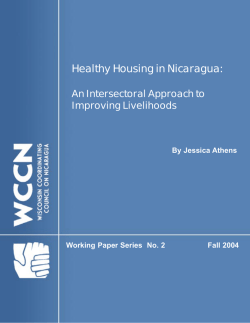
![Download [ PDF ] - journal of evolution of medical and dental sciences](http://s2.esdocs.com/store/data/000488959_1-4dca276881c4179da54bcce462126ef6-250x500.png)
